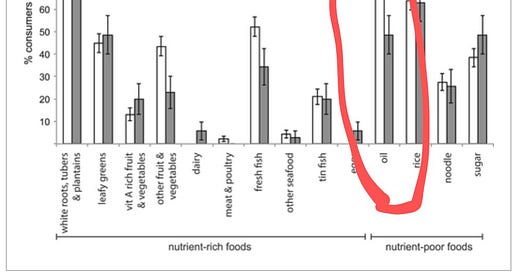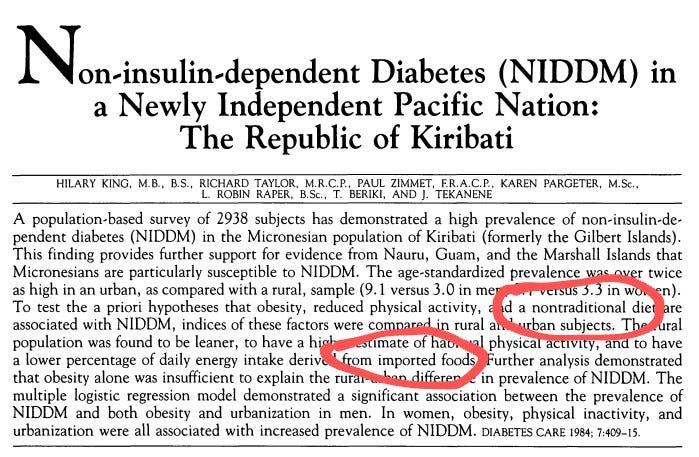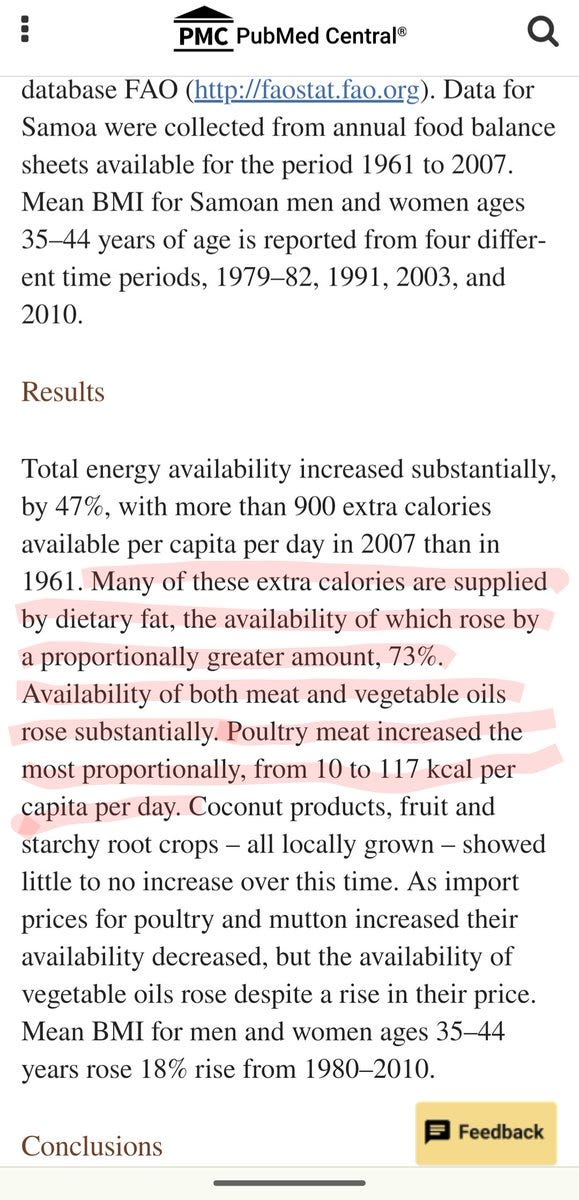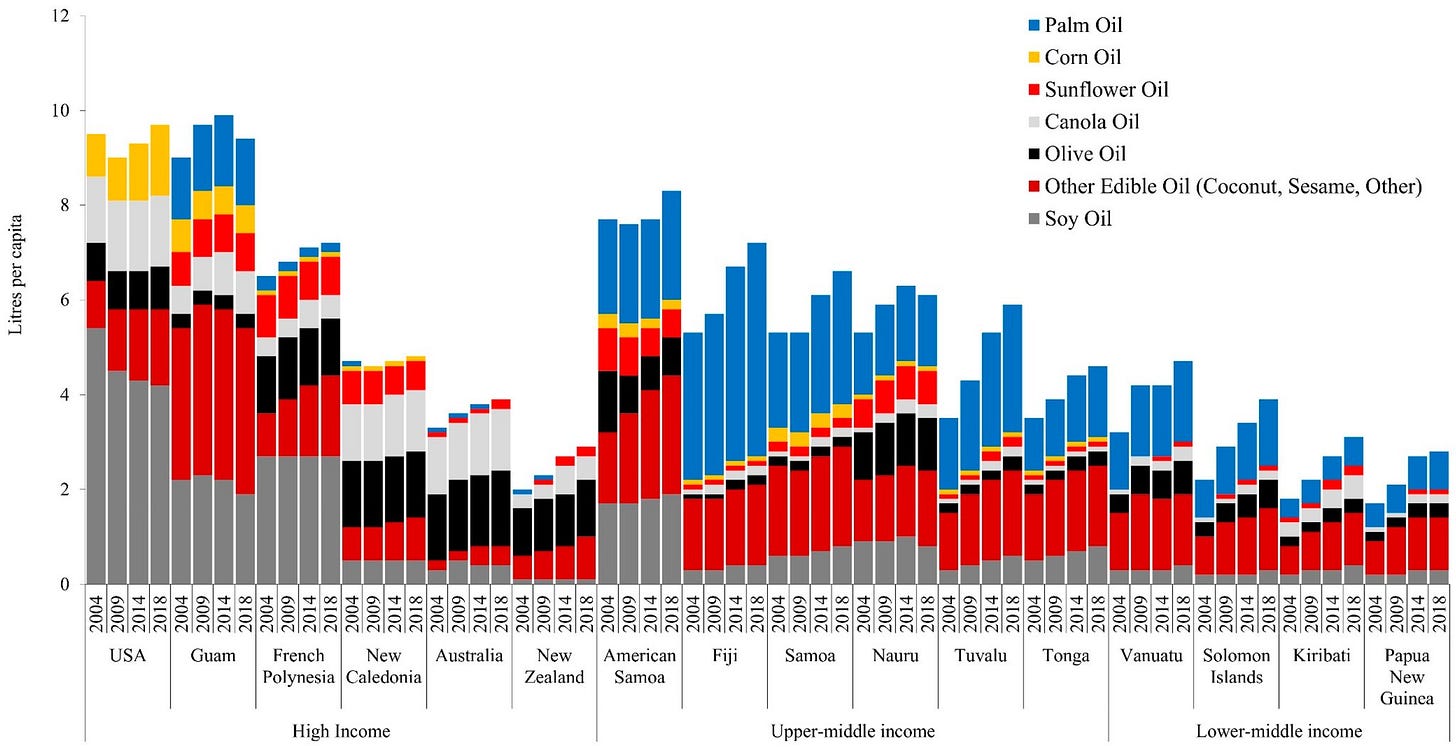Follow-up to Gary Taubes on Omega-6 Fats (Seed Oils) and Obesity
Further discussions about the evidence for seed oils being the fundamental cause of our obesity epidemic.
Are there Black Swans?
So since the I initially published the previous post in 2019, I have had a few interactions with Gary on this hypothesis, both online and off.
Response to Gary Taubes on Omega-6 Fats (Seed Oils) and Obesity
Recently (2019) the Human Performance Outliers podcast with Shawn Baker and Zach Bitter interviewed Gary Taubes. [1]
The offline ones will remain that way, since I haven’t asked for or been given permission to repost them, and have no pressing need to do so.
But I’d like to discuss one that happened recently on X.
Nina Teicholz started it off with this:
“Yes, but there have been tribes and populations that became obese and diabetic without seed oils, which just disproves this hypothesis” *
(Links to posts are in the asterisks for each quoted X post.)
I retweeted it, with the comment:
”Which ones? I went through this with @garytaubes , he couldn't name one.” *
Proposed Black Swans: Samoa, Solomon Islands, Kiribati
Taubes replied:
“You should have asked me again. In his 2017 Medical Hypothesis paper, @ChrisKnobbeMD cites 3: Samoa, Solomon Islands, Kiribati, all with significant ob/db epidemics.
https://sciencedirect.com/science/article/abs/pii/S0306987717305017?via%3Dihub…
In 2017, Chris was using the absence of seed oil consumption in these populations to support his macular degeneration hypothesis. He should have remembered these populations when he moved on to proposing, as you do, that seed oils are the primary cause of ob/db epidemics. These are legitimate black swans.” *
The hint here that something is wrong is in that last image Gary posted.
Kiribati
I replied:
“Are they? Kiribati is eating imported foods and getting fat and diabetic, per your source.
You willing to claim they're the only population on Earth not getting imported processed foods with seed oils? Or maybe it's the animal fats, as they authors claim?
This is not a black swan, it's a confirmation.
I'm sure the rest are the same, I'll look later.” *
(Markups made on the phone aren’t as clean as above!)
Samoa
“Later” came pretty quickly, as I had the time at that moment.
Samoa, the same.
Chicken is the biggest source of Ω-6 fats in the US... [(National Cancer Institute, 2019)]
https://ncbi.nlm.nih.gov/pmc/articles/PMC3323707/…
Come on Gary. *
Solomon Islands
And…
“And last but not least, the Solomon Islands.
https://onlinelibrary.wiley.com/doi/full/10.1111/mcn.12921” *
Problems in Knobbe’s paper
I was curious about this, as Taubes obviously knows how to do research. So I looked into what he had cited as his source.
“As for as Chris's food data, it's not supported by what I can find.
“"In Samoa,... “harmful vegetable oil” consumption remained 0 grams per day from 1961 to 2015." [(Knobbe and Stojanoska, 2017)]
“Not according to this. See attachment.
“"Processed Foods and Nutrition Transition in the Pacific: Regional Trends, Patterns and Food System Drivers" [(Sievert et al., 2019)]
As you can see, the paper shows consumption trends from 2004 to 2018 in various Pacific countries, including the ones mentioned.
Response
(Messages cross on X, and the threading can get all messed up, which is part of the reason I wanted to post this here, instead of just a link to the original post.)
Taubes replied to my Samoa post, above:
“This also isn't very useful, particularly for Kiribati and the Solomon Islands. Lumping coconut oil into the red group with other vegetable oils is a problem.” *
My response:
“Come on, Gary.
“It's not "0 grams per day from 1961 to 2015"
“This isn't hard.
“There's no problem: Chris's assertion that you relied on was wrong. Accept that and recalibrate.” *
“Although if you accept this, you have figured it out.
“"Lumping coconut oil into the red group with other vegetable oils is a problem."
“Coconut is very low in Ω-6.” *
Taubes also replied to my response about Kiribati above (looking at Taube’s image from (King et al., 1984), not to the last post above:
“1. You missed the point: Chris said no harmful vegetable oils back at a time when there was already a diabetes epidemic. If they were eating harmful vegetable oils then it's evidence against his macular degeneration hypothesis. If they weren't, it's evidence against the ob/db hypothesis.
“2. I'm not claiming anything. I'm just using Chris's data, and he is now arguing what you're arguing. I'm also perfectly willing to believe that Chris has this wrong, and that he only believed them then because they supported the macular degeneration hypothesis. But then we have to worry about the lack of skepticism. Why did I have to point this out?
“3. BOTH our hypotheses depend on Kiribati eating imported foods. You're arguing for seed oils as the key. I've suggested sugar and white flour. A black swan would be a population with ob/db [obesity/diabetes] epidemics and no change in traditional diets.
“4. As I wrote in GCBC (that "excellent book") [He’s referring to a comment I made in another post about it being excellent, which it is.] one of the reasons why folks like me had to resuscitate the sugar/processed carb hypothesis is because back in the 1970s-80s, researchers like King et al focused almost exclusively on fat intake or total macronutrients. They did not differentiate into processed vs. unprocessed or even sugar vs. grains/starches. This is a problem below in your Samoa data. They're only looking a fat and protein and paying no attention to possible changes in sugar/sugary beverage consumption. It's conceivable that there were none so they chose not to mention it, but doubt it. I… [sic]” *
That post seems to have been truncated as he sent it. I think this is what he meant to continue, although it’s in a different thread, and 12 minutes later:
“If I am wrong, though, about sugar and processed carbs, and the real problem is seed oils — the trigger of these epidemics — then that would be pretty compelling evidence that the book is, well, not excellent.
“And, regrettably, I do agree with you that Occam's razor tends very much to apply to these epidemics. It could be all of the above — seed oils and sugars/sugary beverages and processed grains — but I've bet against it.” *
My response:
“It opened up the the whole world's eyes to the problems in nutrition 'science'.
“That's pretty excellent, in my opinion.
“You missed the confounder in processed industrial foods.
“Along with virtually everyone in nutrition 'science', even the people prescribing seed oils to cause weight gain.” *
I’m giving myself the last word here. He did not respond to that post above.
If he does, I’ll amend this post, or follow up.
We do seem to agree that, as Taubes said: “A black swan would be a population with ob/db epidemics and no change in traditional diets.”
None of these populations meet that test, regardless of whether sugar or seed oils are causal.
References
Albert, J., Bogard, J., Siota, F., McCarter, J., Diatalau, S., Maelaua, J., Brewer, T., & Andrew, N. (2020). Malnutrition in Rural Solomon Islands: An Analysis of the Problem and Its Drivers. Maternal & Child Nutrition, 16(2), e12921. https://doi.org/10.1111/mcn.12921
King, H., Taylor, R., Zimmet, P., Pargeter, K., Raper, L. R., Beriki, T., & Tekanene, J. (1984). Non-insulin-dependent Diabetes (NIDDM) in a Newly Independent Pacific Nation: The Republic of Kiribati. Diabetes Care, 7(5), 409–415. https://doi.org/10.2337/diacare.7.5.409
Knobbe, C. A., & Stojanoska, M. (2017). The ‘Displacing Foods of Modern Commerce’ Are the Primary and Proximate Cause of Age-Related Macular Degeneration: A Unifying Singular Hypothesis. Medical Hypotheses, 109, 184–198. https://doi.org/10.1016/j.mehy.2017.10.010
National Cancer Institute. (2019, November 30). Identification of Top Food Sources of Various Dietary Components [Informational]. National Cancer Institute, Epidemiology and Genomics Research Program. https://epi.grants.cancer.gov/diet/foodsources/
Sievert, K., Lawrence, M., Naika, A., & Baker, P. (2019). Processed Foods and Nutrition Transition in the Pacific: Regional Trends, Patterns and Food System Drivers. Nutrients, 11(6), Article 6. https://doi.org/10.3390/nu11061328
Taubes, G. (2008). Good Calories, Bad Calories: Fats, Carbs, and the Controversial Science of Diet and Health. Penguin RandomHouse. https://amzn.to/3ImLT3t (Amazon links support this blog if you purchase.)















Very interesting. I travelled to Micronesia in the 90s quite a bit while a family member did research in Palau, and could see for myself that Palauans, at least, loved their Western fast food- it was a treat for them to go to the restaurants in Koror for burgers and fries at lunchtime. Western food was much preferred over traditional foods, and I'm sure it was made with plenty of seed oils. (And it showed- Palauans have a tendency to be heavy in general).
I am curious about the noticeably low intake of oil in general in New Zealand. How are they faring as a population?
Hi Tucker,
Time to go west and east on a seaplane -100 years ago. With Weston A Price.
The only epidemiology for me; Weston A Price and his eskimo etc abo trips 100 years ago, before civilized diet reached them.
His timing was tight but perfect. He could fly and follow the development of traditional diet to tradepost diet, after the roads were built. The change was sugar, flour, seed oils. The change in people, within the same family inbetween siblings, was stunning. The teeth began to decay, the became fat, the jaws became narrower, resulting in the teeth not fitting any more in line. And noses and nostrils became narrower as well; everywhere the signs of developmental disturbances.
They were introduced concentrated glucose (flour), glucose+ fructose (sugar) and concentrated pufa6,. My pick is the excessive combo of sugars and seed oils, because Price's trips to fruit eating tropics found healthy people with no signs of malformations. So major share of sugar laden diet is not sufficient alone to introduce bad things. Although, ancient egypt with their "bread eaters" army and beer loving culture resulted in modern deceases. So, maybe the flour is not innocent after all.
Pretty much what you could pick up from Harvard BS epidemiology: the most fattening food is french fries, when fried in seed oils. Not in saturated fat, though. Pufa6 consentrate was the novel new thing; the combo of sugars and pufa6 is detrimental.
There is another new dimension, fine particle size of processed flour and subseqent products. Let's leave it aside for a moment.
JR